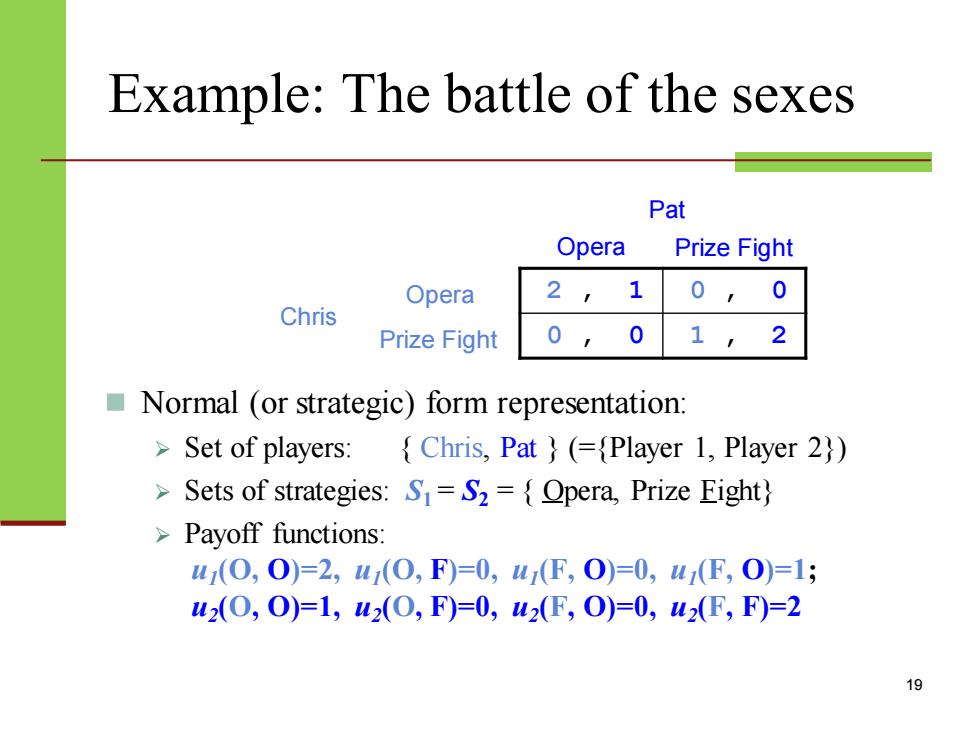
Example:The battle of the sexes Pat Opera Prize Fight Opera 2, 1 0, 0 Chris Prize Fight 0, 0 1 2 Normal (or strategic)form representation: >Set of players:{Chris,Pat }(=(Player 1,Player 2}) >Sets of strategies:S1=S2={Opera,Prize Eight) >Payoff functions: u(0,0)=2,u(0,F)=0,u(F,O)=0,u1(F,0=1; u2(0,O)=1,u2(0,F)=0,u2(F,0)=0,u(F,F)=2
19 Example: The battle of the sexes ◼ Normal (or strategic) form representation: ➢ Set of players: { Chris, Pat } (={Player 1, Player 2}) ➢ Sets of strategies: S1 = S2 = { Opera, Prize Fight} ➢ Payoff functions: u1 (O, O)=2, u1 (O, F)=0, u1 (F, O)=0, u1 (F, O)=1; u2 (O, O)=1, u2 (O, F)=0, u2 (F, O)=0, u2 (F, F)=2 2 , 1 0 , 0 0 , 0 1 , 2 Chris Pat Prize Fight Opera Prize Fight Opera
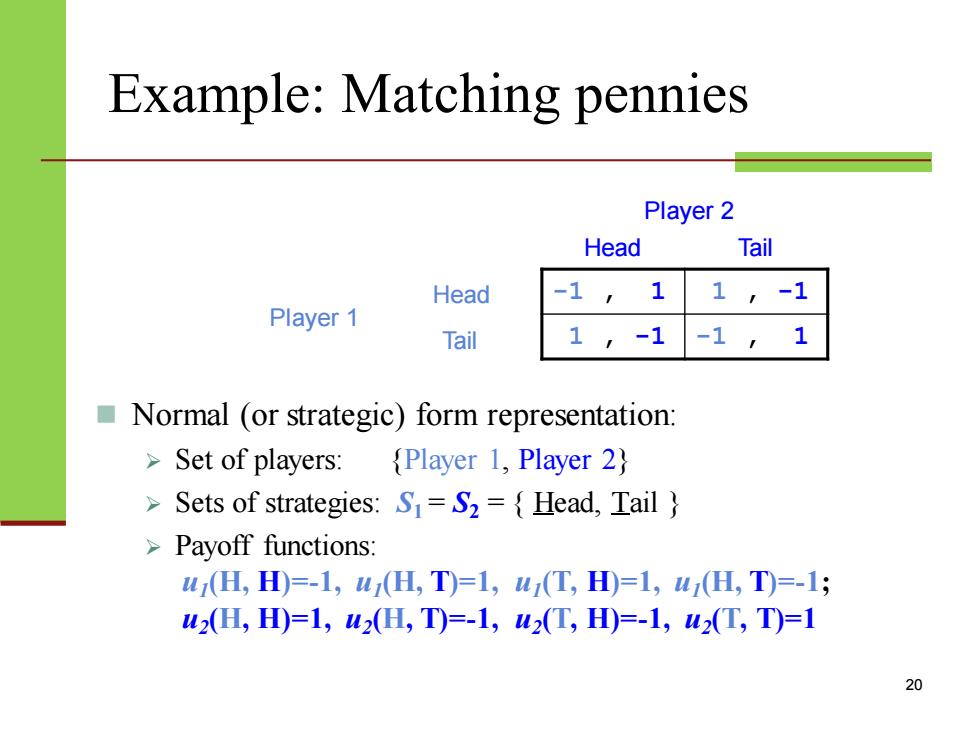
Example:Matching pennies Player 2 Head Tail Head -1, 1 1, Player 1 Tail 1,-1 -1, Normal (or strategic)form representation: Set of players: {Player 1,Player 2) Sets of strategies:S1=S2={Head,Tail Payoff functions: uH,H)=-1,u(H,T)=1,u(T,H=1,u(H,T)=-1; u2(H,HD)=1,u2(H,T)=-1,u2(T,H0=-1,u(T,T)=1 20
20 Example: Matching pennies ◼ Normal (or strategic) form representation: ➢ Set of players: {Player 1, Player 2} ➢ Sets of strategies: S1 = S2 = { Head, Tail } ➢ Payoff functions: u1 (H, H)=-1, u1 (H, T)=1, u1 (T, H)=1, u1 (H, T)=-1; u2 (H, H)=1, u2 (H, T)=-1, u2 (T, H)=-1, u2 (T, T)=1 -1 , 1 1 , -1 1 , -1 -1 , 1 Player 1 Player 2 Tail Head Tail Head
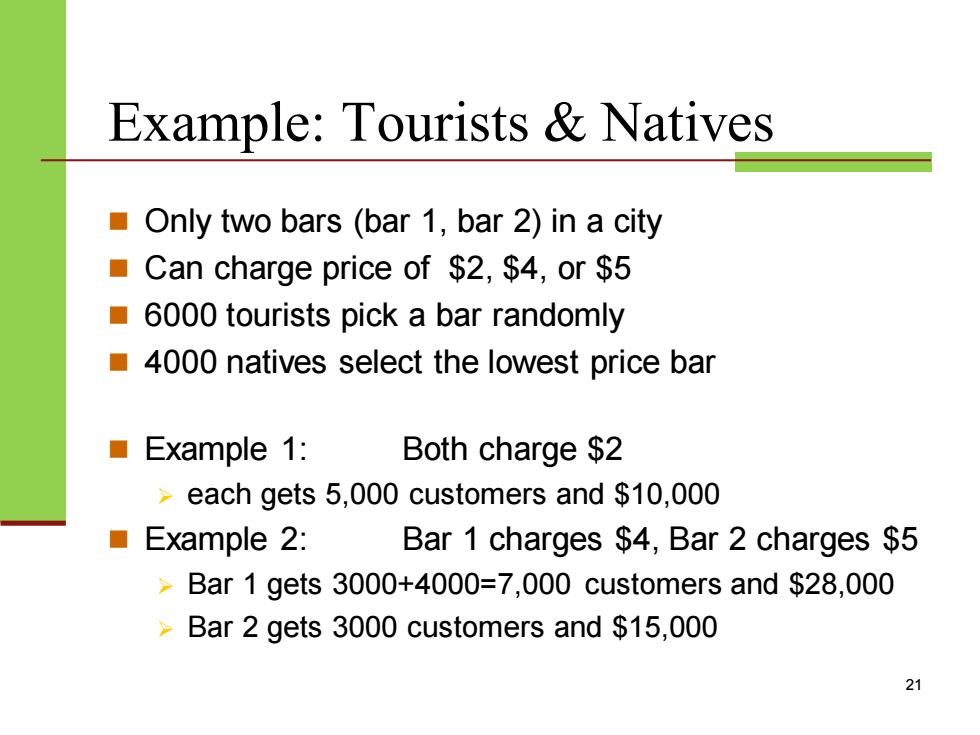
Example:Tourists Natives Only two bars (bar 1,bar 2)in a city Can charge price of $2,$4,or $5 ■ 6000 tourists pick a bar randomly 4000 natives select the lowest price bar ■Example1: Both charge $2 -each gets 5,000 customers and $10,000 ■ Example 2: Bar 1 charges $4,Bar 2 charges $5 Bar 1 gets 3000+4000=7,000 customers and $28,000 Bar 2 gets 3000 customers and $15,000 21
21 Example: Tourists & Natives ◼ Only two bars (bar 1, bar 2) in a city ◼ Can charge price of $2, $4, or $5 ◼ 6000 tourists pick a bar randomly ◼ 4000 natives select the lowest price bar ◼ Example 1: Both charge $2 ➢ each gets 5,000 customers and $10,000 ◼ Example 2: Bar 1 charges $4, Bar 2 charges $5 ➢ Bar 1 gets 3000+4000=7,000 customers and $28,000 ➢ Bar 2 gets 3000 customers and $15,000
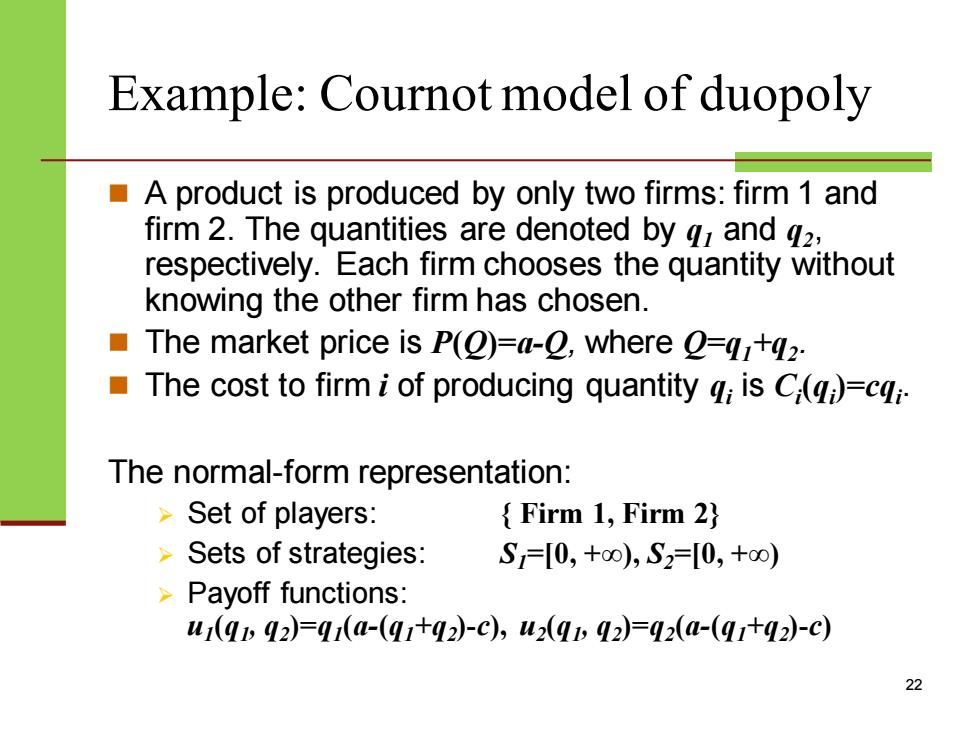
Example:Cournot model of duopoly A product is produced by only two firms:firm 1 and firm 2.The quantities are denoted by q and 42, respectively.Each firm chooses the quantity without knowing the other firm has chosen. The market price is P(O)=a-2,where Q=q1+g2. The cost to firm i of producing quantity q:is C(q=cqi The normal-form representation: -Set of players: Firm 1,Firm 2) Sets of strategies: S=0,+0),S2=[0,+oo) Payoff functions: u(qwq2)=q(a-(q+q2)-C),u(q,q2)=q2(-(q+q2)-c) 22
22 Example: Cournot model of duopoly ◼ A product is produced by only two firms: firm 1 and firm 2. The quantities are denoted by q1 and q2 , respectively. Each firm chooses the quantity without knowing the other firm has chosen. ◼ The market price is P(Q)=a-Q, where Q=q1+q2 . ◼ The cost to firm i of producing quantity qi is Ci (qi )=cqi . The normal-form representation: ➢ Set of players: { Firm 1, Firm 2} ➢ Sets of strategies: S1=[0, +∞), S2=[0, +∞) ➢ Payoff functions: u1 (q1 , q2 )=q1 (a-(q1+q2 )-c), u2 (q1 , q2 )=q2 (a-(q1+q2 )-c)
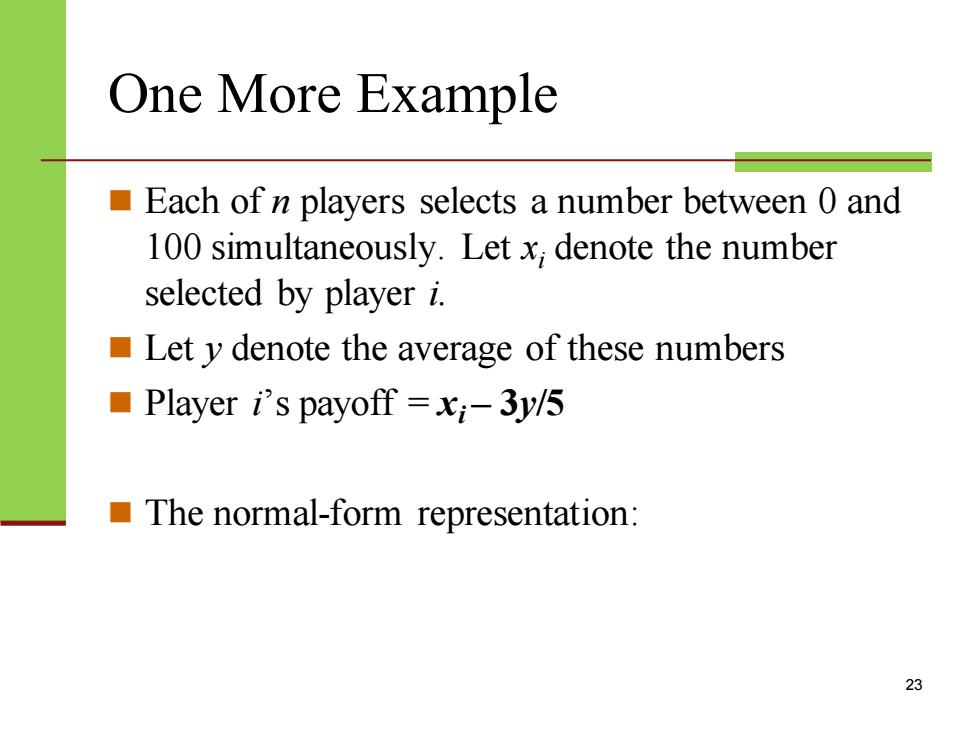
One More Example Each of n players selects a number between 0 and 100 simultaneously.Let x;denote the number selected by player i. Let y denote the average of these numbers Player i's payoff =x-3y/5 The normal-form representation: 品
23 One More Example ◼ Each of n players selects a number between 0 and 100 simultaneously. Let xi denote the number selected by player i. ◼ Let y denote the average of these numbers ◼ Player i’s payoff = xi – 3y/5 ◼ The normal-form representation: